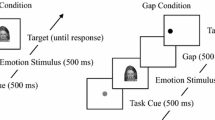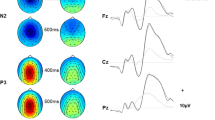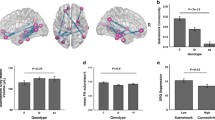Abstract
Dopaminergic brain circuits participate in emotional processing and impulsivity. The dopamine transporter (DAT) modulates dopamine reuptake. A variable number tandem repeat (VNTR) in the dopamine transporter gene (DAT1) affects DAT expression. The influence of DAT1 genotype on neural activation during emotional processing and impulse inhibition has not been examined. Forty-two healthy subjects were classified as 9DAT (n = 17) or 10DAT (n = 25) based on DAT1 genotype (9DAT = 9R/9R and 9R/10R; 10DAT = 10R/10R). Subjects underwent fMRI during non-emotional and emotional go/no-go tasks. Subjects were instructed to inhibit responses to letters, happy faces, or sad faces in separate blocks. Accuracy and reaction time did not differ between groups. Within group results showed activation in regions previously implicated in emotional processing and response inhibition. Between groups results showed increased activation in 9DAT individuals during inhibition. During letter inhibition, 9DAT individuals exhibited greater activation in right inferior parietal regions. During sad inhibition, 9DAT Individuals exhibited greater activation in frontal, posterior cingulate, precuneus, right cerebellar, left paracentral, and right occipital brain regions. The interaction between DAT genotype and response type in sad versus letter stimuli showed increased activation in 9DAT individuals during sad no-go responses in the anterior cingulate cortex, extending into frontal-orbital regions. 9DAT individuals have greater activation than 10DAT individuals during neutral and sad inhibition, showing that genotypic variation influencing basal dopamine levels can alter the neural basis of emotional processing and response inhibition. This may indicate that 9R carriers exert more effort to overcome increased basal dopamine activation when inhibiting responses in emotional contexts.



Similar content being viewed by others
References
Anand, A., Verhoeff, P., Seneca, N., Zoghbi, S. S., Seibyl, J. P., Charney, D. S., & Innis, R. B. (2000). Brain SPECT imaging of amphetamine-induced dopamine release in euthymic bipolar disorder patients. The American Journal of Psychiatry, 157(7), 1108–1114.
Aron, A. R., Fletcher, P. C., Bullmore, E. T., Sahakian, B. J., & Robbins, T. W. (2003). Stop signal inhibition disrupted by damage to right inferior frontal gyrus in humans. Nature Neuroscience, 6(2), 115–116.
Badgaiyan, R. D., Fischman, A. J., & Alpert, N. M. (2009). Dopamine release during human emotional processing. NeuroImage, 47(4), 2041–2045.
Bertolino, A., Blasi, G., Latorre, V., Rubino, V., Rampino, A., Sinibaldi, L., Caforio, G., Petruzzella, V., Pizzuti, A., Scarabino, T., Nardini, M., Weinberger, D. R., & Dallapiccola, B. (2006). Additive effects of genetic variation in dopamine regulating genes on working memory cortical activity in human brain. The Journal of Neuroscience, 26(15), 3918–3922.
Brehmer, Y., Westerberg, H., Bellander, M., Furth, D., Karlsson, S., & Backman, L. (2009). Working memory plasticity modulated by dopamine transporter genotype. Neuroscience Letters, 467(2), 117–120.
Britton, J. C., Phan, K. L., Taylor, S. F., Welsh, R. C., Berridge, K. C., & Liberzon, I. (2006). Neural correlates of social and nonsocial emotions: an fMRI study. NeuroImage, 31(1), 397–409.
Bush, G., Luu, P., & Posner, M. I. (2000). Cognitive and emotional influences in anterior cingulate cortex. Trends in Cognitive Sciences, 4(6), 215–222.
Caldu, X., Vendrell, P., Bartres-Faz, D., Clemente, I., Bargallo, N., Jurado, M. A., Sierra Grabulosa, J. M., & Junque, C. (2007). Impact of the f Val108/158 met and DAT genotypes on prefrontal function in healthy subjects. NeuroImage, 37(4), 1437–1444.
Cornish, K. M., Manly, T., Savage, R., Swanson, J., Morisano, D., Butler, N., Grant, C., Cross, G., Bentley, L., & Hollis, C. P. (2005). Association of the dopamine transporter (DAT1) 10/10-repeat genotype with ADHD symptoms and response inhibition in a general population sample. Molecular Psychiatry, 10(7), 686–698.
Cox, R. W. (1996). AFNI: software for analysis and visualization of functional magnetic resonance neuroimages. Computers and Biomedical Research, An International Journal, 29, 162–173.
Dreher, J. C., Kohn, P., Kolachana, B., Weinberger, D. R., & Berman, K. F. (2009). Variation in dopamine genes influences responsivity of the human reward system. Proceedings of the National Academy of Sciences of the United States of America, 106(2), 617–622.
Felten, A., Montag, C., Markett, S., Walter, N. T., & Reuter, M. (2011). Genetically determined dopamine availability predicts disposition for depression. Brain Behav, 1(2), 109–118.
Fuke, S., Suo, S., Takahashi, N., Koike, H., Sasagawa, N., & Ishiura, S. (2001). The VNTR polymorphism of the human dopamine transporter (DAT1) gene affects gene expression. The Pharmacogenomics Journal, 1(2), 152–156.
Gainetdinov, R., Jones, S., & Caron, M. (1999). Functional hyperdopaminergia in dopamine transporter knock-out mice. Biological Psychiatry, 46(3), 303–311.
Garcia-Garcia, M., Clemente, I., Dominguez-Borras, J., & Escera, C. (2010a). Dopamine transporter regulates the enhancement of novelty processing by a negative emotional context. Neuropsychologia, 48(5), 1483–1488.
Garcia-Garcia, M., Barcelo, F., Clemente, I. C., & Escera, C. (2010b). The role of the dopamine transporter DAT1 genotype on the neural correlates of cognitive flexibility. The European Journal of Neuroscience, 31(4), 754–760.
Goldstein, M., Brendel, G., Tuescher, O., Pan, H., Epstein, J., Beutel, M., Yang, Y., Thomas, K., Levy, K., Silverman, M., Clarkin, J., Posner, M., Kernberg, O., Stern, E., & Silbersweig, D. (2007). Neural substrates of the interaction of emotional stimulus processing and motor inhibitory control: an emotional linguistic go/no-go fMRI study. NeuroImage, 36(3), 1026–1040.
Hershey, T., Black, K. J., Hartlein, J., Braver, T. S., Barch, D. M., Carl, J. L., Perlmutter, & S., J. (2004). Dopaminergic modulation of response inhibition: an fMRI study. Brain Research. Cognitive Brain Research, 20(3), 438–448.
Hester, R., Barre, N., Mattingley, J. B., Foxe, J. J., & Garavan, H. (2007). Avoiding another mistake: error and posterror neural activity associated with adaptive posterror behavior change. Cognitive, Affective, & Behavioral Neuroscience, 7(4), 317–326.
Lahiri, D. K., & Nurnberger Jr., J. I. (1991). A rapid non-enzymatic method for the preparation of HMW DNA from blood for RFLP studies. Nucleic Acids Research, 19(19), 5444.
Lotze, M., Montoya, P., Erb, M., Hulsmann, E., Flor, H., Klose, U., Birbaumer, N., & Grodd, W. (1999). Activation of cortical and cerebellar motor areas during executed and imagined hand movements: an fMRI study. Journal of Cognitive Neuroscience, 11(5), 491–501.
Mata, R., Hau, R., Papassotiropoulos, A., & Hertwig, R. (2012). DAT1 polymorphism is associated with risk taking in the balloon analogue risk task (BART). PloS One, 7(6), e39135.
Mill, J., Asherson, P., Browes, C., D’Souza, U., & Craig, I. (2002). Expression of the dopamine transporter gene is regulated by the 3’UTR VNTR: Evidence from brain and lymphocytes using quantitave RT-PCR. American Journal of Medical Genetics, 114(8), 975–979.
Ondo, W. G., & Lai, D. (2008). Predictors of impulsivity and reward seeking behavior with dopamine agonists. Parkinsonism & Related Disorders, 14(1), 28–32.
Phan, K. L., Wager, T., Taylor, S. F., & Liberzon, I. (2002). Functional neuroanatomy of emotion: a meta-analysis of emotion activation studies in PET and fMRI. NeuroImage, 16(2), 331–348.
Ramdani, C., Carbonnell, L., Vidal, F., Beranger, C., Dagher, A., & Hasbroucq, T. (2015). Dopamine precursors depletion impairs impulse control in healthy volunteers. Psychopharmacology, 232(2), 477–487.
Ralph, R. J., Paulus, M. P., Fumagalli, F., Caron, M. G., & Geyer, M.A. (2001). Prepulse inhibition deficits and perseverative motor patterns in dopamine transporter knock-out mice: differential effects of D1 and D2 receptor antagonists. J or Neuro, 21(1), 305--313.
Rubia, K., Russell, T., Overmeyer, S., Brammer, M. J., Bullmore, E. T., Sharma, T., Simmons, A., Williams, S. C., Giampietro, V., Andrew, C. M., & Taylor, E. (2001). Mapping motor inhibition: conjunctive brain activations across different versions of go/no-go and stop tasks. NeuroImage, 13(2), 250–261.
Sevy, S., Hassoun, Y., Bechara, A., Yechiam, E., Napolitano, B., Burdick, K., Delman, H., & Malhotra, A. (2006). Emotion-based decision-making in healthy subjects: short-term effects of reducing dopamine levels. Psychopharmacology, 188(2), 228–235.
Shafritz, K. M., Collins, S. H., & Blumberg, H. P. (2006). The interaction of emotional and cognitive neural systems in emotionally guided response inhibition. NeuroImage, 31(1), 468–475.
Staley, J., Boja, J., Carroll, F., Seltzman, H., Wyrick, C., Lewin, A., Abraham, P., & Mash, D. (1995). Mapping dopamine transporters in the human brain with novel selective cocaine analog. Synapse, 21(4), 364–372.
Takahashi, H., Yahata, N., Koeda, M., Takano, A., Asai, K., Suhara, T., & Okubo, Y. (2005). Effects of dopaminergic and serotonergic manipulation on emotional processing: a pharmacological fMRI study. NeuroImage, 27(4), 991–1001.
Tzourio-Mazoyer, N., Landeau, B., Papathanassiou, D., Crivello, F., Etard, O., Delcroix, N.,Mazoyer, B., & Joliot, M. (2002). Automated anatomical labeling of activations in SPM using a macroscopic anatomical parcellation of the MNI MRI single-subject brain. NeuroImage, 15(1), 273–289.
Vandenbergh, D. J., Persico, A. M., Hawkins, A. L., Griffin, C. A. Li, X., Jabs, E. W., & George, R. U. (1992). Human dopamine transporter gene (DAT1) maps to chromosome 5p15.3 and displays a VNTR. Genomics 14(4), 1104--1106.
Watanabe, J., Sugiura, M., Sato, K., Sato, Y., Maeda, Y., Matsue, Y., Fukuda, H., & Kawashima, R. (2002). The human prefrontal and parietal association cortices are involved in NO-GO performances: an event-related fMRI study. NeuroImage, 17(3), 1207–1216.
Author information
Authors and Affiliations
Corresponding author
Ethics declarations
All procedures performed in studies involving human participants were in accordance with the ethical standards of the institutional and/or national research committee and with the 1964 Helsinki declaration and its later amendments or comparable ethical standards.
Funding
This project was funded by the NIMH to AA (R01MH075025).
Conflict of interest
None of the authors have any conflicts of interest related to this report.
Informed consent
Informed consent was obtained from all individual participants included in the study.
Electronic supplementary material
Supplemental Table 1
(DOC 61 kb)
Rights and permissions
About this article
Cite this article
Brown, B.K., Murrell, J., Karne, H. et al. The effects of DAT1 genotype on fMRI activation in an emotional go/no-go task. Brain Imaging and Behavior 11, 185–193 (2017). https://doi.org/10.1007/s11682-016-9516-7
Published:
Issue Date:
DOI: https://doi.org/10.1007/s11682-016-9516-7




